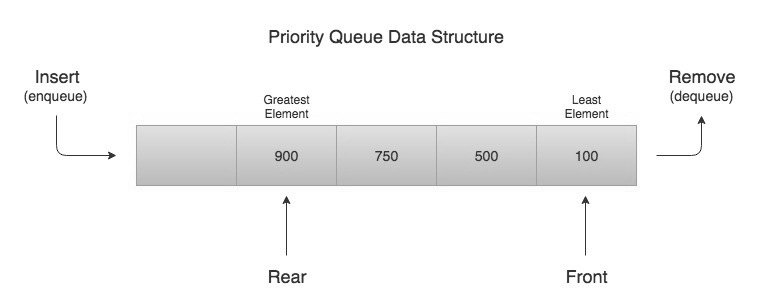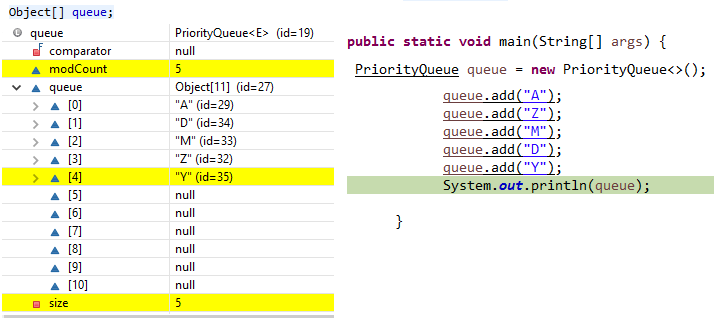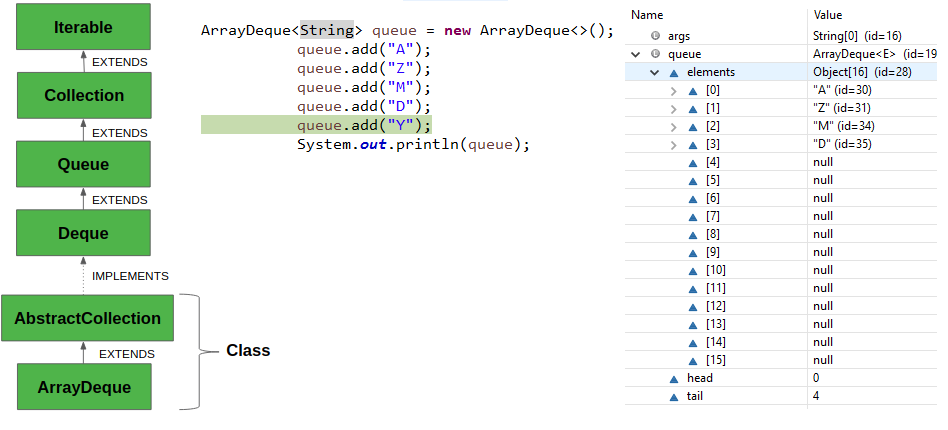Queue
-
The Queue is used to insert elements at the end of the queue and removes from the beginning of the queue. It follows FIFO concept.
-
LinkedList, PriorityQueue are the most frequently used implementations.

PriorityQueue – Internal implementation
A Queue in Java is just an interface. We need a concrete implementation of the Queue interface to work with, in our programs. LinkedList class implements the Queue interface and therefore it can be used as a Queue.
The process of adding an element at the end of the Queue is called Enqueue, and the process of removing an element from the front of the Queue is called Dequeue.
A priority queue in Java is a special type of queue wherein all the elements are ordered
-
as per their natural ordering using Comparable or
-
based on a custom Comparator supplied at the time of creation.
The front of the priority queue contains the least element according to the specified ordering, and the rear of the priority queue contains the greatest element.

So when you remove an element from the priority queue, the least element according to the specified ordering is removed first.
public class Demo {
public static void main(String[] args) {
Queue<Integer> q = new PriorityQueue<>();
q.offer(400);
q.add(200);
q.add(700);
q.add(100);
q.add(500);
while (!q.isEmpty()) {
System.out.println(q.remove());
}
}
}
-------------
100
200
400
500
700
Let’s say that we need to create a priority queue of String elements in which the String with the smallest length is processed first.
We can create such a priority queue by passing a custom Comparator that compares two Strings by their length
Since a priority queue needs to compare its elements and order them accordingly, the user defined class must implement the Comparable interface, or you must provide a Comparator while creating the priority queue. Otherwise, the priority queue will throw a ClassCastException when you add new objects to it.
Constructors of PriorityQueue class
-
PriorityQueue(): Creates with the default capacity (11) &natural ordering.
-
PriorityQueue(int initialCapacity): specified initial capacity & natural ordering.
-
PriorityQueue(int initialCapacity, Comparator comparator)
-
PriorityQueue(PriorityQueue c): Creates a PriorityQueue containing the elements in the specified priority queue.
-
PriorityQueue(SortedSet c): Creates a PriorityQueue containing the elements in the specified sorted set.
public class PriorityQDemo {
public static void main(String[] args) {
PriorityQueue q = new PriorityQueue();
System.out.println(q.peek()); //null //System.out.println(q.element());//java.util.NoSuchElementException
for (int i = 1; i <= 10; i++) {
q.offer(i);
}
System.out.println(q); //[1, 2, 3, 4, 5, 6, 7, 8, 9, 10]
System.out.println(q.poll());// 1
System.out.println(q); //[2, 4, 3, 8, 5, 6, 7, 10, 9]
}
}
---------------------------------
null
[1, 2, 3, 4, 5, 6, 7, 8, 9, 10]
1
[2, 4, 3, 8, 5, 6, 7, 10, 9] //see Order Changed
[2, 4, 3, 8, 5, 6, 7, 10, 9] //see Order Changed
Internal implementation
Priority queue represented as a balanced binary heap: the two children of queue[n] are queue[2*n+1] and queue[2*(n+1)]. The priority queue is ordered by comparator, or by the elements’ natural ordering, if comparator is null: For each node n in the heap and each descendant d of n, n <= d. The element with the lowest value is in queue[0], assuming the queue is nonempty.
private static final int DEFAULT_INITIAL_CAPACITY = 11;
transient Object[] queue;
If array Reaches maximum capacity
queue = Arrays.*copyOf*(queue, newCapacity);
Establishes the heap invariant (described above) in the entire tree, assuming nothing about the order of the elements prior to the call.
@SuppressWarnings("unchecked")
private void heapify() {
for (int i = (size >>> 1) - 1; i >= 0; i--)
siftDown(i, (E) queue[i]);
}

Deque (Double Ended Queue)
The Deque is related to the double-ended queue that supports addition or removal of elements from either end of the data structure, it can be used as a queue (first-in-first-out/FIFO)** or as a stack (last-in-first-out/LIFO). **

ArrayDeque – Internal implementation
The ArrayDeque class provides the facility of using deque and resizable-array. It inherits AbstractCollection class and implements the Deque interface.
The important points about ArrayDeque class are:
-
Unlike Queue, we can add or remove elements from both sides.
-
Null elements are not allowed in the ArrayDeque.
-
ArrayDeque is not thread safe, in the absence of external synchronization.
-
ArrayDeque has no capacity restrictions.
-
ArrayDeque is faster than LinkedList and Stack.
